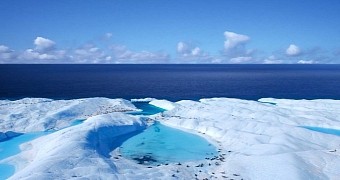Global warming is known to encourage the melting of the Arctic. As it turns out, this phenomenon is by no means a one-way street. On the contrary, the melting of the Arctic influences global warming, and it does so in the worst possible way. Long story short, it fuels it.
Thus, researchers with the University of Southern Denmark say that, the smaller the Arctic's sea ice cover gets, the more carbon dioxide will build up in our planet's atmosphere. Consequently, global warming and climate change will continue to progress.
How the Arctic influences global warming
In a series of articles published in several scientific journals, the University of Southern Denmark specialists behind this research project explain that, according to evidence at hand, sea ice helps keep global warming in check by sucking carbon dioxide from the atmosphere.
This means that, the more the Arctic melts and the less ice covers waters in this part of the world, the more carbon dioxide will remain in our planet's atmosphere. Since this greenhouse gas fuels global warming and climate change, scientists believe that ice loss in the Arctic will push these phenomena into overdrive.
“New research shows that sea ice in the Arctic draws large amounts of CO2 from the atmosphere into the ocean,” researcher Dorte Haubjerg Søgaard said in a statement. Furthermore, “If our results are representative, then sea ice plays a greater role than expected, and we should take this into account in future global CO2 budgets.”
How sea ice toys with the atmosphere's makeup
For a very long while, it was believed that, unlike other bodies of water, oceans and seas that sport a thin layer of ice cannot absorb carbon dioxide. Dorte Haubjerg Søgaard and fellow researchers say that this is not true, and that frozen seas and oceans play a major part in the planet's carbon cycle.
“The chemical removal of CO2 in sea ice occurs in two phases. First crystals of calcium carbonate are formed in sea ice in winter. During this formation CO2 splits off and is dissolved in a heavy cold brine, which gets squeezed out of the ice and sinks into the deeper parts of the ocean,” explains Dorte Haubjerg Søgaard.
“Calcium carbonate cannot move as freely as CO2 and therefore it stays in the sea ice. In summer, when the sea ice melts, calcium carbonate dissolves, and CO2 is needed for this process. Thus, CO2 gets drawn from the atmosphere into the ocean - and therefore CO2 gets removed from the atmosphere,” he adds.
Due to global warming and climate change, the Arctic's sea ice cover in summer is about 30% smaller than it used to be. Besides, the layer of ice that forms in this part of the world in winter is considerably thinner than it used to be just decades ago.
If the University of Southern Denmark are right, this means that sea ice in the Arctic is absorbing less carbon dioxide than we would like it to, and that this region of the world is gradually becoming a contributor to climate change and global warming.
“If our results are representative, then sea ice plays a greater role than expected, and we should take this into account in future global CO2 budgets,” specialist Dorte Haubjerg Søgaard commented on the outcome of his and his colleagues investigations.

 14 DAY TRIAL //
14 DAY TRIAL //